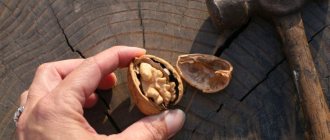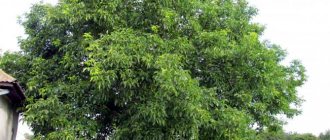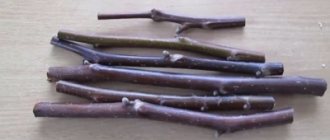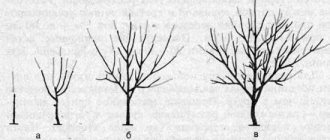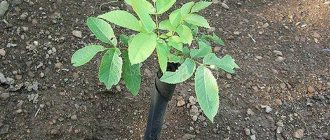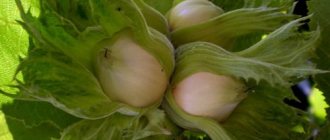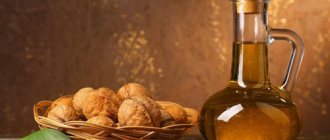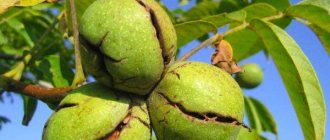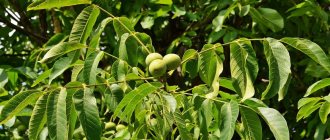[ads-pc-1]
As a relatively faster way to obtain the first harvest, compared to sowing seeds, there is also a very common method such as walnut grafting. A walnut, properly grafted with cuttings, allows you, if you have mature trees on your farm (and it doesn’t matter what variety), to harvest your first harvest in 3-4 years . Propagating walnuts by cuttings is a simple procedure and is not much different from that of other fruit-bearing trees. However, of course, there are a number of nuances that we will definitely consider with you below in the text. Next, we will try to cover the topic “how to graft a walnut.”
So, how to graft a walnut?
First, let's clarify the terminology a little. A rootstock is a tree onto which buds are grafted from previously prepared cuttings, which in turn are called a scion . As a rootstock tree, it is most logical and natural to use absolutely healthy trees about 2 years old. As a rule, walnut grafting is carried out in the 2 most effective ways: the copulation method and budding. Copulation is the connection of a scion and a rootstock with each other into oblique cuts of a special shape. Mirror-shaped sections are formed on the sprouts, which during the grafting process are superimposed on each other and securely tied until they grow together. Budding is the grafting of one scion bud onto specially prepared rootstock wood.
Advice from professionals
Experienced gardeners recommend not uprooting old trees. You can put the budding technique into practice and save a dying or poorly fruiting plant by grafting.
Any attractive southern cutting can be grafted onto a frost-resistant walnut variety, which will actively bear fruit.
For successful grafting, the seedling should be taken to a good place and cared for for 2 years to be used as a rootstock.
The rootstock and scion for grafting must be of the same age for the most effective tissue fusion.
In old trees, fusion processes are significantly slower
Walnut grafting in summer. Propagation by green cuttings (grafting using the pipe method).
Most often, summer walnut grafting . This procedure is probably the simplest and ensures good survival rate. Walnut grafting is carried out in the summer, usually in mid-summer - in July (at day and night temperatures of at least 230C). Walnuts are propagated by green cuttings and by budding.
From the scion, using a special knife with two parallel blades rigidly fixed relative to each other, a part of the bark with a healthy bud is carefully removed and placed on a previously prepared area of the rootstock shoot, from which the same section of bark is removed at a height of approximately 7-10 cm from the soil level . The scion, cleaned and moistened with a damp cloth, is securely wrapped to the rootstock with plastic wrap so that only the eye of the bud remains visible. Next, you monitor and provide good care for the resulting seedling. If the bud turns green over time, then the winding can be loosened, and after 2-3 months it will be generally better to remove it. From this bud we will get a grafted seedling. walnut grafting is also quite often called .
Rootstock selection and preparation
For the rootstock, it is recommended to use varietal walnut seedlings grown from seeds no older than 3 years. Ideally, these will be two-year-old trees with a trunk diameter of 1-1.5 cm.
The choice of rootstock must be made based on the climatic conditions of the region where the tree will be grown. Most often, walnut is grafted onto seedlings:
- nuts of cultivated varieties (Pyatiletka, Urozhainy, Zarya Vostoka) - they are the most compatible, tolerate frost well and produce a large harvest, and the scion takes root well;
- rock nut - it is better to choose varieties with medium or strong growth, but it is worth considering that not every soil is suitable for them and the trees may suffer in a particularly frosty winter;
- Hinji nut - characterized by high productivity from the third year of life and resistance to diseases, but do not tolerate cold winters well.
Walnut grafting in winter into clefts and by copulation method.
The second most common method is propagation of walnuts by cuttings , grafting of which is carried out in winter . Good survival rate is also noted here, but the procedure for grafting walnuts in winter is much more labor-intensive and time-consuming.
First, in advance, namely in late autumn, both the rootstock and the scion are prepared. Cuttings are carefully selected from already fruit-bearing trees, which are healthy shoots from 7 to 15 mm thick, and up to half a meter in length, with well-developed buds. Until winter sets in, they are stored in a container filled with sawdust or, alternatively, sand, at an outside temperature of 0 to 5 degrees Celsius. The rootstock will be healthy seedlings germinated from the nut, which will need:
- carefully dig up without damaging the root system,
- pack in polyethylene
- cover the roots with wet sawdust or sand,
- provide the same storage conditions as for the scion.
- ensure that the substrate is watered 1-2 times a month, and if it dries out earlier, it can be done more often.
3-4 days before grafting, usually in February or March, place the rootstock and scion in warm conditions (26-280C) and sprinkle with wet sawdust.
Next, walnut grafting is carried out using the 2 most effective methods:
– copulation,
- into the cleft.
What rootstock should I take?
When choosing a rootstock, you need to give preference to the plant that is most resistant to the climate in a particular region. The most promising seeds are those that have increased frost resistance, for example, Manchurian or gray walnut.
Manchurian
The growing region of Manchurian walnut is Primorsky Krai, China, Far East. To increase the frost resistance of a tree, it is recommended to graft Manchurian and walnuts. It is possible to do such a vaccination, but the procedure itself is complicated.
Budding is in progress. To do this, all the wood from the shield is removed, after which the peephole is attached. You can also graft with cuttings. The problem only arises if the diameter of the trunks differs. It is enough to make a longitudinal cut and release the juice
The survival rate is only 25-48%, so it is important to perform the procedure correctly and care for the tree
Grey
Gray walnut grows up to 30 meters, and in order to use the best properties of this plant during propagation, gardeners recommend grafting in the summer. The tree grows quickly, but needs constant moisture.
In the first winter after grafting, the gray walnut needs to be cared for especially carefully. It tolerates low temperatures well, but in severe frosts it is recommended to wrap the bottom of the tree with film to protect the roots from freezing.
Black
For an American black walnut scion, it is best to use the rootstock of a regular walnut variety. One and two year old seedlings are used. Gardeners most often use black walnut, because its survival rate is 100%.
Cordate
The unusual shape of the heart-shaped nut fruit makes gardeners use this plant for grafting and transfer the properties of the variety to new trees. The average height of a nut is up to 15 meters, but in the Moscow region it grows no higher than 10 meters. You can grow this variety of nut at home, on your own plot. To preserve all the properties of the tree and increase the chances of a positive result, it is recommended to do summer grafting.
Siebold Walnut
The survival rate of a tree when grafted ranges from 50 to 78%. Conical stamen buds are used for grafting.
One-year-old seedlings should be selected, but two-year-old seedlings are also suitable. This method of propagation is the best way to transfer the best characteristics of a variety to a new tree, and to combine the characteristics of two trees of different varieties. The method of budding or copulation is used.
Walnut copulation
The advantage of walnut grafting using the copulation method is the large area of connection between the rootstock and scion, which has a more positive effect on the fusion of the future seedling. In addition, the grafting site is easier to tie and can be better secured.
At a distance of about 10 cm from the root collar of the rootstock, an oblique cut is made with a very sharp knife in one sharp movement.
Next, you need to step back a quarter of its length from the upper end of the cut and make an incision, as a result of which a tongue is formed at the bottom. A similar procedure is carried out with the scion, only the tongue is cut out at the bottom. Next, the scion and rootstock are connected in such a way that one tongue goes behind the other, and their layers coincide along the entire cut, as in the picture below.
Grafting into walnut splits.
Cleft grafting is usually used when the rootstock is larger in diameter than the scion. First, the upper part of the scion is cut off with pruning shears. Next, use a knife to split the rootstock to a depth of 3 cm in the middle of the trunk - if the parts to be joined are almost equal, and closer to the edge - if the scion is smaller in diameter than the rootstock. The cuttings are cut in the shape of wedges, so that the bark remains on one side for better connection of the grafting parts.
All cuts and connections must be made quickly to prevent the surfaces of the boles from oxidizing. After connecting the rootstock and scion, the grafting site must be carefully and tightly tied with polyethylene and placed in boxes for stratification. Before laying out each new row, you need to cover the roots and the grafting site with wet sawdust or perlite.
What trees can be grafted on?
To graft a tree, you don't have to use only walnuts. When choosing, you need to focus on the climatic conditions of the growing region.
You can take into consideration the main cultural species:
- grey;
- Manchurian;
- black;
- in the shape of a heart;
- hinji;
- productive;
- Siebold nut (ailanthophyllum).
To obtain seedlings, it is recommended to take seedlings of the above species that are 1-2 years old. When it comes to walnut seedlings, it is better to choose those that are less than a year old, since their survival rate is an order of magnitude higher. To compact this tree, peach, cherry, plum, hazelnut, and dogwood are used. If everything is done correctly, then within a few years the walnut will delight its owners with the first harvest of incredibly healthy fruits.
Caring for grafted walnut seedlings.
After vaccination, stratification is carried out for 25-30 days at an air temperature of 26-280C and air humidity from 85% to 90%. During this period, the sawdust should not be allowed to dry out by periodic watering. Stratification can be considered complete when a circular callus forms around the “adhesion” site. Sometimes at this time the seedlings develop buds and the root system is restored. These seedlings are planted in a container and kept at room temperature until planting, periodically watering them with warm water. Seedlings with dormant buds can be returned back to the box and moved for storage to a room with a temperature of 0-3C. In the spring you can start planting ready-made seedlings.
There is also the practice of grafting walnuts in spring or autumn , but due to the not very good survival rate, it is used extremely rarely , and there is no point in paying much attention to it.
As you have had the opportunity to notice, the process of propagating walnuts by cuttings is quite meticulous and requires certain gardening skills. However, with desire and due diligence, this exciting business, in a few years, will definitely bear fruit in the form of an excellent harvest!
Aftercare rules
After grafting, the tree needs special care. The vaccination site is constantly checked after removing the bandage; it must be dry. Weak cuttings are first shortened and then cut off when the tree begins to grow quickly. You need to take care of the strongest cuttings. It is necessary to regularly clear the soil of weeds and carry out summer watering.
Closer to winter, they stop watering the tree so as not to slow down the growth of seedlings. A prerequisite for good growth of a grafted nut is the use of potassium, nitrogen and phosphorus fertilizers. They must be used in accordance with the instructions:
- In summer, nitrogen fertilizers are scattered around the trunk. On average, up to 25 grams of fertilizer should be used per 1 square meter of land.
- In autumn, 35 grams of potassium chloride and 130 grams of phosphates are added. For a tree under 10 years of age, this amount of fertilizer is normal. In hot summers, the same bait is used, but in liquid form.
The condition of the leaves determines how quickly the walnut will grow after grafting. To speed up the growth and preserve the tree, it is necessary to pay attention to the fight against pests and tree diseases and use fertilizers. It is important to ensure that all leaves are healthy and, if the first signs of disease are present, to quickly eliminate it. Chemicals are strictly prohibited for young nuts.
Folk remedy for the prevention of walnut diseases:
- pour 2 tablespoons of tobacco, onion peels and garlic into a three-liter jar;
- the workpiece is poured with boiling water and left for 7 days;
- then the solution is filtered and the tree is sprayed with it, after diluting the tincture in 10 liters of water.
If pests do appear, to get rid of them, you need to pour 5 liters of water into 500 grams of wormwood and yarrow and leave for two days. The infusion is cleaned, boiled and cooled, and before use it is diluted in 10 liters of water.
A tree infected with aphids or codling moths should be sprayed once every ten days.
